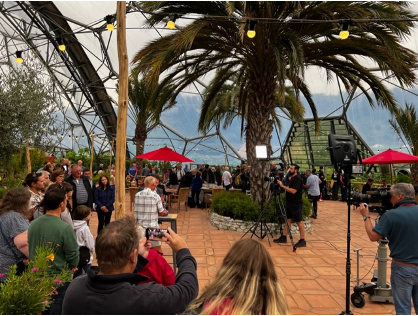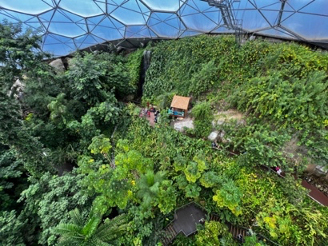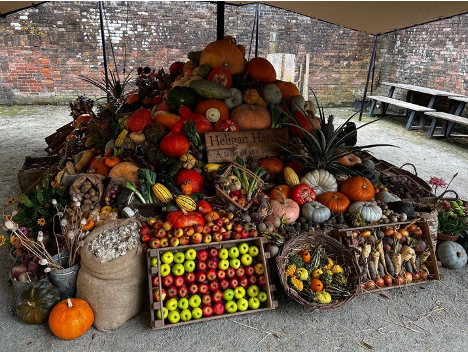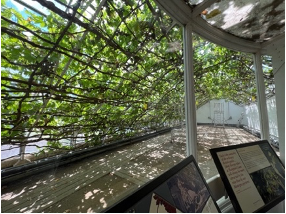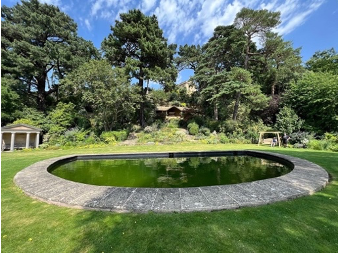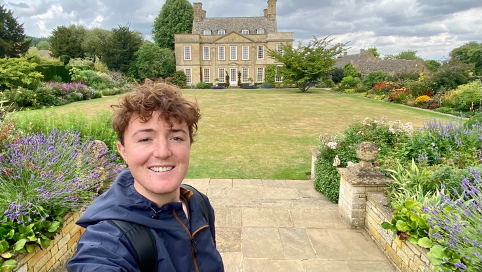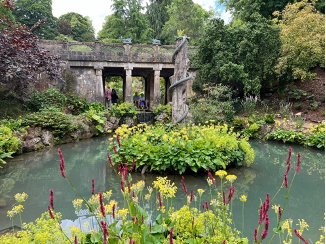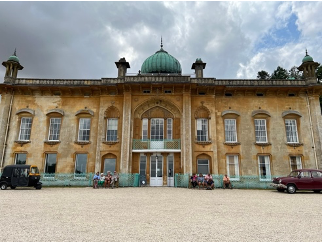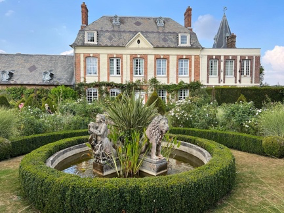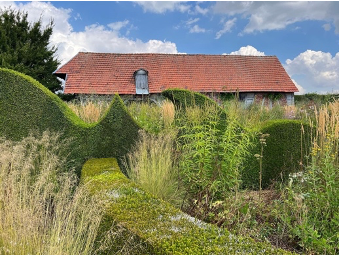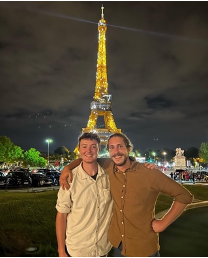Photo of me in ‘The Jungle’ at the ‘Lost Gardens of Heligan’.
Ash Walker
2021 Horticulture
Sponsored by Independent Garden Centres IGC and The Ryde Student Fund
G’day, I’m Ash Walker and this is my Global Footprints Horticultural Scholarship adventure.
None of this would have been possible without the generous support from Independent Garden Centres IGC and The Ryde Student Fund, who sponsored my scholarship. My sincere thanks go IGC and Ros Andrews for the generous funding, and to every single person who mentored and supported me through this incredible adventure.
I hope you enjoy the read! All of this is from a diary that I kept throughout the whole trip!
Planning the trip
It all started back in late 2019, when I heard about the Global Footprints Scholarship from a work colleague (Justin Longhurst, Nursey Manager at Welby Garden Centre).
I was intrigued about what this opportunity could provide, so I decided to apply when applications opened in April of 2020. After the long hours of putting my application together I sent it through, and on the 13th of August 2020 I received a phone call from the CEO of Global Footprints, to inform me that I had been awarded a 2021 Global Footprints Scholarship. You couldn’t wipe the smile off my face. I was so excited to what the future could bring, so I went home that afternoon and started planning the trip.
My first hurdle that I had to jump was Covid-19, because at that time the world was in a pandemic. We couldn’t leave our homes, let alone fly halfway around the world. I had to wait an extra year until I could eventually begin my trip, but I didn’t let that year of waiting go to waste. I wanted to take this time to grow my knowledge and contacts within the industry.
Planning the trip - building a network
I started this in early 2021 at Mayfield Garden, a long-standing sponsor of Global Footprints Scholarships, working a casual position as a horticulturist. I worked every Monday for 4 months gaining experience and learning new skills which became very valuable with its similar climate to the UK.
I also attended several conferences, garden talks and garden shows, one show of which was the Melbourne International Flower and Garden Show (MIFGS). I volunteered on the Australian Garden Conical stand, talking to the public about how horticulture is much more than just weeding and mowing lawns. In fact, there are over 100 different career pathways in horticulture that you can explore. I also volunteered alongside Tyler Howard, the 2019 Global Footprint scholar at MIFGS Collectors Plants fair. We were invited to speak on 2GB Radio on the Garden Clinic with Graham Ross to talk about our scholarships. We took a lot of inspiration and motivation from these events leading up to our trip which certainly became a steppingstone to what else was to come.
Throughout the year I kept in contact with Graham Ross AM, an Australian horticulturalist, author, tv and radio presenter, Chair of the Australian Garden Council and Ambassador for the Global Footprint’s Scholarship. First Graham asked me where I would like to go, and I answered ‘everywhere‘. I said I would like to go to UK, France, Singapore, USA, Japan, Netherlands and Scotland, and Graham’s response was that I’m quite ambitious but need to cut down the list. So, I did, and I emailed Graham back with placements ideas in the UK and France. Graham said that’s better, and we began the planning. Graham put me in contact with several people overseas. One of which was Andrew Fisher Tomlin, (owner of London Collage of Garden Design and Fisher Tomlin & Bowyer). Andrew helped me with organising 3 placements and introducing me to all of them, RHS Chelsea Flower Show volunteering for three weeks for designer Kate Gould and working on (out of the shadows) Sanctuary Garden, the Royal Botanic Garden, Kew, and a day of volunteering at the RHS Hampton Court show, working with Designer Samuel Moore on the show garden (the sun lifestyle outdoor living garden).
After emailing all the placements for a few months and keeping in touch with Graham and Andrew, I planned to be overseas for six months, starting in May and finishing in November. I had five different placements planned, with four weeks at each location, working as a Horticulturist, which would entail garden maintenance and soft landscaping work. The six main placements were;
The RHS Chelsea Flower Show
The Royal Botanic Gardens of Kew
National Trust Hidcote Manor House & Garden
Claude Monet’s Garden in France
The Eden Project, and
The Lost Gardens of Heligan.
Planning the trip - logistics
I then had to organise visa’s, travel insurance, accommodation and flights which was a little bit of a headache to figure out with it being my first time travelling overseas. I contacted some pervious Global Footprints Scholars, and I got advice from 2013 Kate Grace, 2015 Grace Scott and 2017 Jessica Smith. I also asked around the horticulture industry and the Global Footprints team. With everyone’s help and advice I decided to get the T5 Youth mobility Visa for the UK. This would allow me to be in the UK for 2 years and allows paid work but not public funds. I got this visa because I wanted to come back the following year and possibly do paid work.
Travel Insurance was easy. I just had made sure that I had all the insurance covers that’s required. I went with One Cover travel insurance, because I heard a lot of great reviews, and it had the cover that I needed.
Accommodation was easy. I looked at a few different options including hostels, Airbnb, student accommodation and house sitting. After all the research, I decided to just go with Airbnb’s. Hostels was an option, but a lot didn’t look right, and you could say a bit dodgy.
When booking flights, it was probably the most exciting and stressful part of planning because it made the whole trip feel real. I booked with Emirates to fly out at 9:10pm on the 12th of May. Now, with all the hard work done, all I had to do was wait.
For future scholars, please check websites and do a bit of research yourself because what I did might not be relevant at your time.
Take off
The weeks of waiting turned into days, then it became the night before I was going to hop onto the plane and set off to another country for six months. Do you think I got any sleep? H*** NO! I was so excited for the journey ahead. That afternoon all the family drove me to Sydney International Airport. I was feeling pretty good and optimistic about the trip. As I said bye to the family for now and walked up the tunnel, I felt a feeling that I’ve never felt before, and that was a feeling of adventure, excitement, nervousness, and something else that I can’t put into words but something like the feeling of being or a new beginning. Once I was on the plane everything was okay and now all I had to do was try to get some sleep. The flight was an absolute killer, 14 and a half hours stuck in a confined space, not fun but we got through it and before I knew it, I have landed in Dubai. Nice city could only see it from the airport, which was massive. I had to take a bus just to get to my next gate. Pretty fun thought, the airport itself is nice, very flashy and you could tell that there’s a lot of money in Dubai but once my four-hour layover was done, it was time to get onto the next plane to London. Seven and a half hours later, I landed on the 13th of May at 2:00 in the afternoon.
First Days in London
Once I left the airport, I went straight to my Airbnb that I booked in Roehampton and passed out asleep for a couple hours. When I woke, I thought I’ll go for a little explore around the area, it was an eye opener, as it was so different from Australia, the builds, people and just the old look of the place. It’s like stepping back in time. That afternoon, I meet up with Tyler Howard, who had arrived only 2 days before I did. It was so great seeing someone familiar; we stayed out that night checking out London.
The following days I explored London and visited Buckingham Palace, Big Ben, Kensington Gardens, Chelsea Physic Garden and RHS Garden Wisley. Buckingham and Big Ben was certainly top on my list to visit first, amazing to be in the presence of so much history. One thing I noticed was the amount of people around – they were packed in like sardines. Kensington Gardens was sensational, well maintained and structed very nicely. The Queen Mary Rose Gardens was beautiful, I was there at the right time with everything in flower and looking fantastic. It’s London’s largest collection of roses with around 12,000 roses planted in the gardens, a must see.
Chelsea Physic Garden is an intriguing garden, I took a lot away from visiting the garden and found that wherever you looked, there was always something interesting to see and read about. There’s a collection of native Australian and New Zealand plants that was discovered by Sir Joseph Banks, when he joined the voyage of discovery in 1768 – 1771 to the Pacific Ocean aboard the HMS Endeavour, led by Captain James Cook. He had been given a mission to search for the continent now known as Australasia, the unknown land of the south. His team set off in search of new species of trees, shrubs, and plants. All of Joseph Banks’ plants are on display, along with all the other amazing plants in the garden. Another must see.
RHS Wisley Garden, one of the best RHS gardens I’ve seen so far. The garden is 240 acres of land and covers all types of garden styles, design and is most renowned for the quality and detail in the garden. Which is very impressive when you take in account the size of the garden. I only spent a day at Wisley exploring the gardens, I highly recommend anyone to visit.
Adventuring around London was a definitely an eye opener, seeing Big Ben, Buckingham Palace and all the other amazing landmarks but nothing could prepare me for the onslaught that was about to happen at Chelsea Flower Show.
RHS Chelsea Flower Show
15th of May - 28th of May
I worked at The Chelsea Flower Show with Kate Gould the designer of “Out of the shadows” Sanctuary Garden as a horticulturist, planting and demonstrating plant maintenance in the garden display.
The first day at Chelsea was a ride. I remember waking up at 5:30am to head off to Chelsea and where I met Kate Gould (the designer of the garden), Keith Chapman (the foreman of the build) and the rest of the team. There wasn’t much chit chat because it was straight into the work. I was amazed at the amount of detail. From working at the Melbourne flower show to Chelsea, it was certainty a few levels up. You couldn’t have pots showing, I was told that they grow 100 of one plant and only use two or three in the garden, which blew my mind!! I had to clean the dust off the leaves of the Rhaphiolepis. That’s the level you must work at, when at Chelsea.
I was beginning to understand the seriousness of what needs to be done. By this time, it was lunch, my mind was running 100 miles an hour. I went for a walk around the show to see the other gardens and wow, just trying to get around was a mission, with thousands of people around, just insane! Finally, I managed my way around the people, to see the other gardens. It was very interesting to see the other concepts that other designers think of, there was no two gardens that were the same. Each garden was unique, with their own style, colour palette and message that the garden is trying to send. Each designer of a garden has a brief that they must follow and try to replicate and explain their brief though their design of the garden. I believe every garden did very well. After my walk around, I went to moving soil and leveling at the ground getting ready for planting. Rachel Goozee (a garden designer from Brighton) and I went through all the plants, picking out the best-looking ones to go into the garden. The shape and the health of the plant are very important. We went through cutting off the sick and dead branches. With all this done, it was about 6pm and I was knackered. Straight back to the Airbnb to prepare for tomorrow.
The next week and a half were out of this world!! Start at 6:30am and go all day until 9-10pm, absolutely insane but the most fun and excitement I’ve ever had working on a garden. Once in a live time experience!! The last few days of the build leading up to the show was manic! All the hard and most of the soft landscaping was done, the swim spa was in and getting filled up with water, all the big trees were planted, most of the paving was completed, so now we just needed to focus on planting the rest of the plants, a little paving and just making sure everything is clean and looking fantastic.
For the last few days, I was working with Kate. She would place the plants in the garden where it best fits the design, and I would plant them. Working with Kate was a pleasure, I learnt so much from her. One thing I learnt was that it’s not just about planting a plant, but you need to take into consideration the positioning and angling of the plant. For example, say you want to plant a fern under a small tree, you would need to position it to where it would naturally grow up towards the sun, since every plant doesn’t grow straight up, so we needed to angle it in a way that would represent it growing in its natural environment.
Even working on the build and talking to Kate and the team, has started my new passion for garden design and is something I now see myself doing in the future.
The day of Judging arrived at 7am and we all started cleaning everything up to prepare for prejudging which is where the judgers walk around to the gardens to make their assessment but that’s not the final decision, that happens tomorrow. The prejudging was at 9am, so that didn’t give us much time to clean everything, but we got it done. It was good, a couple of other gardens were really rushing to get their garden completed. Keith was telling us that in previous years, they were at the show until 12pm the night before judging, still putting the last touches on the garden, so this year was a chill ending. When the judges arrived most of us had to leave the garden or go for a walk around the show. When we came back Kate and Keith were happy with what the judges said. They both thanked all of us for the help, which I thought was nice. The rest of the day was chill, just watering the plants and making sure everything looked its best for tomorrows official judging.
The next day, I didn’t work, and it was only a few people on the garden. The judges went through that morning, and it would be until the day after which was Monday (the media day, when Queen Elizabeth II visited the show). I didn’t work on the media, but Kate told me that when she and Keith arrived at the garden on the Monday morning there was a Gold Medal, Best Construction and Best in category awards. We all got the great news not long after and I was over the moon, so happy and wow, I was on a high. You couldn’t ask for any more than that. I was with Tyler Howard at the time, and he also got the news that the garden he worked on got a gold medal too!! You couldn’t wipe the smiles off both our faces.
I was fortunate enough to get one of the Gold Medal Plaques from Kate, which she presented to me at a later date. I felt so lucky and privileged to receive my own gold medal from Kate. Now it sits framed in my room and that’s certainly something I’m going to hold onto for the rest of my life.
Show day, which was the Tuesday, was awesome. I worked every day of the show, and it was mad with the amount of people that attend the show, 168,000 people visit the show for 5 days per year. That’s 33,600 people per day, in such a small area. Don’t forget the millions watching on the tv. It was cool seeing all the stars of the industry doing their interview with Kate in the garden and even meeting a couple, like Adam Frost and Monty Don. I remember, the line up just to see Kate’s Garden was 10 people deep. A few times I had to walk the main avenue and seeing herds of people to get through, just insane! Being at the show was an experience I won’t forget, such amazing gardens on display and even chatting to all the other designers, they were always happy to share their ideas and give me a bit of advice on designing a garden and the process of building theirs. Andrew Fisher Tomlin was also at the show. We met up, had a coffee together and Andrew gave Tyler and I a tour through a few other gardens. It was cool having the rope opened for you and being able to walk in while the rest of the crowd gives you a dirt look.
It was the best. Working on the project with Kate and the team at Chelsea was such an AMAZING experience. The long days, hard physical hours, not to mention the blood, sweat and tears we put into this garden to come away with a Gold Medal, Best Construction and Best in Category certainty made all the hard work, worth it and it demonstrated the amount of passion we all have for the garden and the industry. I thank everyone and I’II be back soon, hopefully one day with my own garden design. Being at Chelsea and meeting all the awesome people and having the pleasure to work at such a renowned garden show was one of the highlights of this trip. Again, a massive thank you to Kate and the team, you guys made it a fun time with plenty of laughs. Can’t wait to work with you legends again.
The Royal Botanical Gardens, Kew
6th of June - 1st of July
After the madness of Chelsea, I started at Kew Gardens, one of the most prestigious botanical gardens in the world. During my four weeks at Kew I worked with the Arboretum team maintaining the grounds around Kew. I also did a day each in the palm house and the temperate house. I also got a tour from Carlos Magdalena, a science and horticulture researcher who works in the tropical nursery. It was amazing being around some of the rarest, coolest, and most endangered plants in the world. The work that all the staff do at Kew to care and research these plants is just amazing to see. It really shows the passion that the staff have towards this fantastic industry of horticulture.
On my first day at Kew I was super excited to get started, so I woke up at 6:30 and got the bus to Jodrell gate, the north-east Gate of Kew, to meet Martin Staniforth, Training Manager, School of Horticulture Gardens Directorate at Kew. After we had a little chat, Martin took me over to the Arboretum, to meet Tony Hall, Head of the Arboretum, and Rebecca Lane, Arboretum Supervisor. After the great introduction to Kew, I started work with Valerie and Leif, Horticulturists in the Arboretum team. We began weeding and pruning in the Mediterranean garden and did so for the rest of the day. It was a chill start! After work, I went for a walk around Kew and, wow, checking out the Palm house, Temperate House and the Princess of Wales Conservatory was insane. I’d seen so many photos and videos about these world class glass houses, but to walk inside them was a cool experience. To immerse myself in the history and knowledge within the grounds of Kew’s glass houses was exhilarating. After my three hours walk, I headed back to the Airbnb, which was cool because it was 8 at night and still light out, it gets dark about 11pm in summer. Super awesome!
Most of the four weeks I was working with the Arboretum team, but I did also get a day’s work in the Palm house, Temperate house, and a tour of the Tropical Nursery with Carlos Magdalena, Science and Horticulture Researcher and Author, and Sam and Robert, who both work in the Tropical nursery. The Tropical nursery is insane, the best I’ve ever seen. The plant collection has the most exotic, strange, rare, and cool plants in the world, my eyes were falling out of my head, haha. The level of expertise is just amazing. The wealth of knowledge that you can learn from is world class. I also got the pleasure to met Richard Barley, Director of Kew Gardens, who always has his door open. Great to see another Aussie in the garden. Richard and I had a chat about the issues with the warmer weather and how it’s affecting the plants, environment, and with now plants requiring more water, the need to update the irrigation system.
My day in the Temperate house, started with meeting Caleb, Kew diploma student. I was working him today. We started with watering.
I was put in charge of the Australian collection, nice to have the smell of home. We then did some maintenance in the house. Caleb was showing me a few of the rare and exotic plants. Very interesting! That afternoon we had to pot up two Dictyosperma album palms and finished the day off with a little tour of the glass house chatting about the plants and history of Kew.
One thing that impressed me and that I learnt from Kew was the sustainable methods of pest management and weed control. With pest management they would use beneficial insects, physical barriers and traps and eco-friendly sprays as a last resort. I found this to be a practice with all my placements in UK and France. Australia can certainty learn a thing or two.
On the last day, I got up early and set off to Kew. I arrived at 7am, and first I wanted to go see Martin Staniforth and Richard Barley, but they weren’t there. Instead, I went to the arboretum and there was a meeting on, the team congratulated me on my hard work and gave me a few gifts, which was nice. Then for the last day I was put with Valerie, we started with planting some plants and weeding the Mediterranean garden. I ended up doing this for the whole day, which I enjoyed. After work, I went over to see Carlos, Richard, and Martin to say bye and thanks for having me. They all were very happy.
Working at Kew was the best, I leant so much about different plant species, ways of pest management and weed control, and of course working with such a passionate team. Thank you!
National Trust Hidcote Manor, House & Garden
5th of July – 29th of July
Hidcote Manor is a world-famous garden located in the Cotswolds of the UK, created by passionate plantsman Major Lawrence Johnson in phases from 1907 to 1938.
Hidcote was a very enjoyable experience. I worked at Hidcote for four weeks, in the middle of the heat wave. It was interesting seeing the effects of the heat on the plants, that are clearly not used to the hot weather. Working with the team was great and learning the history of Hidcote and how it came to be through Lawrence Johnson’s vision. My work consisted of helping maintain the grounds, working in their propagation nursery and helping with their pest management methods.
On the 5th of July, I got the train from Richmond in London to Honeybourne in the Cotswolds. I woke up early that morning, packed everything up and left the Airbnb at 9am. I went straight to the train station, to get the train at 10am. I got on the train, and I had to change trains at Reading, it only took about an hour to get here. When I got off the train, I only had 6 minutes to get the next train to Honeybourne, 5 platforms away. I was running with my 30kg suitcase up and down stairs to the platform and as I was coming down the stairs, I could see the train beginning to move so I yelled out, but the train wasn’t stopping. So, I had to wait another hour and half for the next train, great. Time went by fast, so it wasn’t too bad. I got the next train at 1pm, all sweet now. I arrived at Honeybourne, at 2:30pm and got the taxi to Hidcote, which was only a 15 minutes’ drive away. I arrived at Hidcote Manor at 2:45pm and met Thomas Jackson, Training Manger and Horticulturist.
Thomas showed me around the garden, and I met a couple of the other staff. One of the great things about my placement here at Hidcote was that I was allowed to stay in the manor house. I felt very privileged and appreciative to be given the opportunity to stay in such an iconic place. After the very nice introduction, I walked down to Mickelton, the closest village with shops. When I got back, the garden was closed, and the staff was going home for the day, so I had the whole garden to myself. I walked around the garden for the afternoon with no one else around, it felt very strange but cool.
First day of work, I was very excited so woke up at 6am and started at 8am. I walked down to meet the team. There’s 8 gardeners that work at Hidcote. The National Trust also gets volunteers that come and work in the garden. There are between 4 – 8 volunteers, some days more and some less. The first job was for a small group of us to cut down a large area of plants. We did this until morning tea. It was fun working with the volunteers and chatting about the history of the area, which I found very interesting. We finished that job, then went onto weeding and mulching and continued this until we finished for the day. There was a lot of visitors in the garden. I heard that they come by the bus loads! That was great to see. Then I chilled out for the afternoon and waited until everyone left for the day until I had an afternoon stroll around the garden, which was a perfect way to end the day.
The biggest thing I learnt from Hidcote was, like at Kew, the sustainable method of pest management.
I worked in the propagation nursery for a few days and the team would release beneficial insects throughout the glass houses, which I helped with. I found it a great experience to be hands on and see the different insects that they use, methods for dispersing the insects and learning more about the impacts of chemical spraying. When it came to the methods of maintenance, it was very traditional, which I liked! They would use hand tools and equipment rather than power tools, which I believe is a much more sustainable and ecological method of maintaining plants. This is again one thing I noticed all over the UK and France, which is a good thing for the rest of the world to follow.
On my last day working at Hidcote, before heading back to London, I woke up early, eager to start the day. I worked with Mike, a Horticulturist, in the nursery, and we had to build a shade house in the veggie garden, so that they can grow plants on, to be planted in the garden. We did this for the whole day, which wasn’t too bad, a bit different from what I had been doing. We didn’t finish it but got far into it. When work ended, I walked around saying goodbye to everyone because I had to leave early the next morning. Then I chilled out for the afternoon and had one last walk around the garden. My time a Hidcote was a very memorable experience, especially staying in the manor house and having the whole garden to myself. I was certainly the lord of the manor!
Claude Monet’s Garden, France Giverny
31st of July – 31st of August and 23rd of October – 6th November
Wow, Claude Monet’s Giverny. I was amazed with the quality of the garden. The team do such a sensational job at recreating the garden through Claude Monets paintings and records.
I was at Claude Monets for four weeks and worked in different areas of the garden. I started in the Clos Normand, which is in front of the manor house. This part of the garden has two sides, the east and west, where flower clumps of different heights and shapes create a very diverse area, and in the middle are fruit and ornamental trees. Then you have the water garden, where Claude Monet created ‘Bridge over a Pond of Water Lilies’, one of his most famous paintings. One of my favourite memories was in the boat cleaning all the leaves out of the pond and having hundreds of tourist taking photos of me. Such a cool experience.
Traveling from London to Paris, the day started off with me getting up at 9am and leaving my Airbnb at 11am to go meet Tyler Howard at his Airbnb. We had to catch the bus from London to Paris, so we waited around until 8pm. We got the uber to Victoria Coach Station and left on the bus at 9:30pm.
The bus ride wasn’t too bad. A 2-hour bus ride to Dover on the coast of the UK, where we waited for an hour for the bus to go onto the ferry. We then got off the bus and walked around the ferry for a couple hours and before we knew it, we were at Calais dock in France. Back on the bus, and after a 4-hour sleep, we arrived in Paris at 8am. We got off the bus, left the station and walked around for a little bit. After that, we got the uber to St Lazare train station. We had to book train tickets, but we couldn’t figure out the ticket machine because it was in French, so we just booked the tickets on the phone instead. Much easier. Then we were on the train, and after an hour we had arrived at Vernon. We were told that there is a bus that we can get to Giverny, so we got off the train and walked out of the station. We could see the bus but as we approached the bus it took off. Nooooooo! So, we ended up getting the uber to Claude Monets, which was only a 10-minute drive.
Jan Huntley, Head of Munn Artist and Volunteer Programmes, greeted us with the biggest hug ever, that was nice!
While Tyler and I were working at Monet’s, we were also provided with student accommodation on site, which we felt very privileged and appreciative for. We took our suitcases to the accommodation before Jan gave us a tour of the garden and introduced us to a few of the workers. Everyone was super nice and cheerful. Later that night Jan put on a dinner for us and a few other students/seasonal workers that worked at the garden. Jan, that was the most kind and special thing you could do! Merci beaucoup, very appreciated! We finished the night, and I went back to the room, wow what a day!
On the next day, I got up early and was excited to start. Tyler and I started in the nursery planting seedlings in the field above the glass house. We were planting thousands of different perennials, annuals, and biennials that are planted into the garden at the end of the year.
When we were planting, there was a team ahead of us sanitising the soil by using a tractor that made steam to kill the weeds below. The tractor had a square metal plate that laid on the soil, it heats up water to about 120 degrees, to kill the weeds. This happens by leaving the plate on the surface for 10-15 minutes, this causes intercellular water to expand and rupture the cell membrane and consequently the weed will dehydrate and eventually die. Steaming allows for a more rapid transfer of lethal heat into the cell structure of the weed. This is something that I was very happy to see. I’d never seen this done before. So interesting to see this in action, by using this method you stop crop contamination, unlike spraying herbicides or hand digging steaming reduces risks to the safety and health of the operater, soil and environment, plus doesn’t lock up nutrients. A method that needs to be implemented into everyday use in weed control management.
We did the planting until morning tea, after which I went into the west garden to prune roses into umbrella shapes, which is how they have always looked since Claude Monet’s time. It was fun, because I was in the middle lawn area with hundreds of people walking by taking photos of me. I felt famous, haha!!!
Before I knew it, it was lunch and just one of the many things I liked about France was the lunch breaks. I certainly couldn’t complain, ha. After lunch I went back to the west garden to finish off pruning the roses, and then finished work at 2:30, you beauty. When we finished, Tyler, Owen (another intern working at Monets) and I, had an explore of Claude Monet’s house. Wow, the house was just full of paintings of the garden, with a few others. So awesome to walk in the footsteps of the famous painter.
I got the opportunity to design the bouquets for the Claude Monet house, one downstairs in the dining room and the other upstairs in one of the bedrooms. It was such a pleasure, and I thank Owen for helping and giving me the opportunity.
Working in the water garden at Monet’s was definitely one of my highlights from the whole trip!
My first day in the water garden was certainty an interesting day. I started 7 in the morning and met Pierre, a full time worker in the water garden. He got me to start on the boat, cleaning the pond, taking fallen leaves out of the water. This was very fun because at 9am, they let the public into the garden, and if you’re on the boat in the pond, you will get swamped with people taking photos and wanting to talk to you. I was a celebrity, haha. You barely get any work done but it was super cool!! At morning tea, I went up to Jan’s courtyard because that day I had a call back home with Graham Ross for the IGC (Independent Garden Centre’s) conference. That was fun, they had me on the big screen. It was great to chat with Graham and see everyone. It was almost lunch time, but I went back on the boat in the pond for 20 minutes posing for everyone’s photos, haha. I went and had lunch with Jan and a few other gardeners and then back down to the water garden. To finish off the day, Chloe, an architecture student doing a work placement, and I had to re-construct climbing roses growing on these spiral structures, pruning dead and diseased branches, then re-spiralling the climbing roses back onto the structure. At 2:30 my workday ended. Full on but awesome.
On another day, I worked inside of the pond going around the Nymphaea’s, cutting off dead leaves and making them more presentable.
My last day working started by heading down to the water garden and Manu, a full time worker in the water garden, got me watering around the sides of the pond, then weeding and pruning close to the tunnel that goes under the road and connects the whole garden together. I did this until lunch time and that day everyone was having lunch together to farewell Raphaelle, Tyler and me. That was so nice. It was super sad to leave Giverny, working at Claude Monet’s and being in France was certainly a highlight of my travel. I’II come back, and I would highly recommend anyone visiting.
Thank you everyone at Monet’s, I loved every minute working with you guys. Merci beaucoup, j’espere vous revoir tous.
I enjoyed Monet’s so much, that I came back for another two weeks close to the end of my trip. It was interesting working in the colder months. It was much quieter with fewer visitors, and most of the plants in the garden were about to get ripped out! The garden gets pulled up at the start of November, when bulbs and tulips are then planted. Then in April/May the garden is replanted with all new perennials, annuals and biennials, the only plants that stay in the ground are the roses and a couple perennials. Plants like dahlias are dug up recorded, packed, and stored over winter until they are replanted in April/May. This happens each year. The first plant to go was the nasturtiums. So sad. They look so good. For my last week, everyone from all teams were pulling most of the plants out. I did enjoy working with everyone together, but sad that the garden was getting all torn up. I look forward to coming back and planting all the new plants back in the ground and having the garden looking amazing again!
The Eden Project, Cornwall
5th of September - 3rd of October
I spent four weeks at Eden, working with all the teams in all four areas of Eden. I first started in the Mediterranean Biome dome, which was very interesting seeing the methods of pest control in the dome. There was no chemical use at all, Eden’s mission is to create an educational and social enterprise that’s helps build the relationship between people and the natural world to demonstrate the power of working together. This is important with the world we are living in now because in the future we are going to have to look towards more sustainable and innovative ideas to create a world where plants and people can thrive together. Working in the Gardens and Estates team was great, it was interesting seeing the methods of maintaining the grounds and not using any petrol. They just used electric equipment.
Working the Rainforest Biome dome was fascinating, seeing how the team maintain and care for all the trees inside of the dome. With the potential for trees falling over or branches snapping, it was interesting to see the process that the team goes through to prevent such an event. The Rainforest dome was the biggest out of the 2 and going up the shy walk really gave you a perspective of the dome and the amazing engineering that went into the build. This is really an incredible achievement.
On my first day at the Eden Project, I woke up early at 6am and got ready for Robin Lock, Head of Living landscapes, to pick me up at 8am. We went for a drive round Eden, and Robin was giving me a rundown on the history of Eden and their global mission, which is to create a movement that builds relationships between people and the natural world to demonstrate the power of working together for the benefit of all living things.
I believe that we all can achieve this world mission in conjunction with communicating better and demonstrating innovative and sustainable horticultural pest and disease control, and also management and maintenance practices to make a greener future.
After our drive around Robin dropped me off at the Mediterranean biome dome, where I started. My first job was weeding and cleaning up the citrus garden because someone important was coming today. The ‘Antiques Road Show’ was also filming the whole day. There was a couple times I would sneak in front of the camera and pretend to be weeding just to get in the shot. We continued working until morning tea and after Daren, a horticultural student, and I drove around Eden a little more. We had to drop off some green waste and headed back down to the Med dome. When we pulled into the shed, 2 black SUVs showed up and about 10 people in black suits walked out. They were a security team checking out the dome for security threats. This was just before lunch. We were all pondering who could it be. I had no idea but the team thought it could be someone from the royal family. So we finished lunch and after that honestly didn’t do much. We just waited. At about 3pm everyone was told that the person is about to show up, so we were all waiting at the doors and guess who walked in? Camilla Queen Consort of the United Kingdom, at the time Duchess of Cornwall. Note: This was four days before Queen Elizabeth II passed away. When she walked in, I was so amazed. My eyes were flying out of my head. So she walks into the dome greeting a few people and goes over to do her interview with the Antique Road Show that went on for about 10 minutes. I remember, a few of us hopped up on the garden bed to get a better view and pretending to weed. After her interview she began to walk down the path shaking people’s hands. I was on the opposite side to her but that didn’t stop me. I walked across the path put my hand out and shook her hand. Surprised I didn’t get tackled by her security, haha. I was nice and had a 2-minute chat with her and Fiona Bruce, British journalist, newsreader, and television presenter on the Antique Road show. I also got a photo!! I was so happy and couldn’t have asked for a better start to the Eden Project. Thank you Rose and Mark, I had a great day! After my chat with Camilla and Fiona, I was so happy, you couldn’t wipe the smile from my face. Camilla then greeted a few other people, then moved on and that was the day finished. I packed up the tools and walked back to Eden’s Yard Backpackers where I stayed for the placement. I saw Neal and Julia, they run Eden’s Yard Backpackers, and told them about my wonderful day. I called and messaged back home. Everyone couldn’t believe who I met; it was so awesome.
Working in the domes was an educational experience, much the same to my past placements. The pest and disease controls that are in place are very environmentally friendly and sustainable. In both domes there isn’t any chemical spraying done, they use beneficial insects in control pest. One day Sofia, a horticultural student, and I walked around the rainforest biome dome, checking pest numbers and seeing if there were any infestations or an increase of numbers of any pest species. We were happy to report that, since the last check numbers have gone down, which showed that the current pest management controls are working, which was beneficial insects.
Working in the Estates and Gardens teams was certainly interesting also, getting a perspective from outside of the domes of the whole landscape was an eye opener. Both the Estates and Gardens teams manage and maintain the grounds of the Eden project. Their methods of maintenance were old fashioned compared to Australia’s methods but I preferred the traditional ways. I thought it brought you more in touch with the environment and it is a greener way. It was quite a fun and interesting time working with the Estates and Gardens teams and there was a lot I can take from working outside of the domes.
As I set off to Eden on the morning my last day there was a nice sunrise on the way! During my last week I had been in the rainforest dome. I went to the shed and started the day. Jim, an intern doing a research project, and I worked together pruning and weeding around the dome. After lunch, Leo, a horticulturist, and I walked around the dome and Leo was telling the process he goes through when assessing the trees in the dome, checking for the potential for branches or trees that could fall. It was very interesting learning about the safety procedures that you must go through. We walked around for the rest of the afternoon until it was time to finish.
Thank you very much Eden, I can’t wait to see what new thing comes out of Eden and hopefully see a fair few Eden projects popping up around the world.
The Lost Gardens of Heligan, Cornwall
4th of October – 7th of October
I spent one week at The Lost Gardens of Heligan, working with the Productive and Jungle teams. On my first day, I headed off to Heligan with Martin, a horticulturist at Heligan. I worked with the Productive team, helping arrange the harvest with all different veggies. I enjoyed doing this as it brought out my creative side. Towards the end of the day, I worked with Kate, another horticulturist at Heligan, and we pruned the apple trees growing over the archway and put compost around them.
I worked with the Productive team for two days, then worked with the jungle team for two days also.
During my first day down in the jungle, John, also a horticulturist at Heligan, and I did a walk around to check the paths for fallen branches and any branches that had the potential to fall. We did this for an hour and John also gave me a tour of the jungle. After morning tea John and I went around cutting bamboo and re shaping them. After lunch the team allowed me to have an explore on my own of the jungle and garden. It was amazing!
Even though my time at Heligan was short, I still picked up a couple things. It was interesting comparing Eden to Heligan, because the creation of Eden came from the idea of Heligan, and I could certainty see the similarities between the two but also a couple things that sets them apart from each other. I absolutely loved my time at Heligan, I got a photo on the rope bridge where later King Charles III walked across.
Seeing the giant Gunnera Manicata, wow everyone was right, it is massive! The history that this garden holds is amazing. The gardens were created by members of the Cornish Tremayne family from the mid 18th century to the beginning of the 20th century. The garden was lost in 1914, when the estate’s workforce of the gardeners marched off to World War 1, many never returned. Then in 1990, the gardens were re discovered by Tim Smit when a chance of meeting with Tremayne descendant John Wills took him to Heliagn where they disused the possibilities of opening a rea breeds farm. This is when they both came across the ruins of Heligan and from that day the garden has come back to life.
Thank you very much for having me, enjoyed every minute, I’II be back to visit!
Other gardens I visited, UK and France
UK:
National Trust, Ham house and garden, London
Beautiful garden, worth a visit. Extensive and amazing 17th century gardens, restored and with cherry shaped parterre filled with lavender and colourful flower borders, including one of the oldest orangeries in the British Isles.
Hampton Court palace, London
Summer is the best time visit, the spectacular herbaceous borders, the fantastic queen Marys lower orangery garden and you can see the Great Grape Vine. The Great vine, Vitis vinifera ‘Schiava Grossa’ is now 250 years old and is the largest grape vine in the world, The vine was planted in 1768 for King George III and still stands today.
Super bloom, at tower of London
The display is made up of around 20 million seeds that are sewn to create the display, it looks amazing
Kiftsgate Court Gardens, Cotswolds
The garden was created in the 19th century by Heather Muir and was helped by Lawrence Johnson, who created Hidcote Manor and garden, just a kilometre away. The garden has stayed in the family and was passed down two generations of the women gardeners, the present one being Anne Chambers, sensational garden and worth a visit!
Bourton House and Gardens, Cotswolds
Certainly, one of the most well kept and colourful gardens I’ve seen, a wonderful summer garden with plenty of flowers in bloom.
Sezincote House and Garden, Cotswolds
Sezincote is an Indian style garden with ponds, a little pavilion and garden beds that fill the landscape, where you’ll find many rare plants. This is a different garden compared to all the others I’ve seen here in the UK but certainly one of the best.
Trebah Garden, Cornwall
Trebah is a sub-tropical garden with a stunning coastal back drop, the garden is loaded with ginormous Gunnera manicata, or giant rhubarb. This is a sensational garden.
France:
Chateau de Versailles, Gardens
This is one of the largest and most magnificent gardens in the world, the gardens of Versailles are truly a work of art, built on the order of Louis XIV in 1661 and designed by the famous landscape designer Andre Le Notre. The gardens were considered just as important as the palace and took over 40 years to complete, a monumental task, marshes and grasslands were cleared and large amounts of soil had to be shifted to lay out the flower beds, the fountains, the orangeries, and the canals. Trees were brought in from all corners of France and thousands of men worked together to bring the gardens to life. It is worth a visit, you won’t regret it, especially the night show.
Les Jardins d’Angelique
Jan Huntly took Tyler and I out to visit Les Jardins d’Angelique, amazing garden and the lady that manages it all by herself was the sweetest lady ever. Beautiful garden can’t wait to visit again!
Le Jardin Plume
Jan Huntly took Tyler and me out to visit Le Jardin Plume, a different garden from d’Angelique but still amazing with its grasslands, orchids and absolutely loved the cloudy pruning. I liked that the garden was left to grow in its natural way and the management of the garden was certainty unique. For example: the gardeners would prune the Buxus hedge to look like the wind was blowing over the hedge. If you’re in the area, have a visit.
Bonus Experience
Working Hampton Court Show
4th of July
I worked one day at the Hampton Court Show on a garden designed by Samuel Moore. I arrived mid-morning after an absolute mission to get there with buses and Ubers, then a long walk but I got there. My first impression of the show was that I liked how it was much more spread out compared to Chelsea. You can move around easier, rather than being shoulder to shoulder as fewer people visit Hampton Court compared to Chelsea. The gardens on display were very impressive, with a different array of garden designs and styles, with some very interesting layouts and meanings behind the gardens. The day was filled with chatting to members of the public and having a mosey around to all the gardens. It was a fantastic day, and I would highly recommend checking the show. I know, I’II be back. Thank you, Samuel, and Andrew Fisher Tomlin, for organising my placement.
Working with Kate Gould in her landscaping company
10th of October – 21st of October
I worked with Kate Gould and the team in her landscape company ‘Kate Gould Gardens’ for two weeks. During the first week, I did more of the soft landscaping jobs with landscaper Ryan. We did planting and irrigation jobs in and around London. It was fun, I learnt about irrigation and garden design from Kate which was so interesting. Working with Kate and being at Chelsea has inspired me and piqued my interest in garden design.
I did a day with Keith Chapman, the project manager working at Kate Gould Gardens, which involved going around to different nurseries and checking out the different plant species and varieties. They were very different from back home. The plants were similar but here there was more varieties and, in some cases, totally new plants. For the second week, I worked at a site in central London. This job site was new, so I did hard landscaping with the team, which was still interesting. Something new from what I’m used to, hard landscaping was my first interest when I was young. It was a great week which went fast, but it didn’t help that I was sick for all of it. I was very annoyed with myself because I got sick, but we soldiered on. Working with the team was a fantastic experience, I learnt a few things along the way. Thank you, Kate, Keith, and the team for having me. Much appreciated!
Conclusion
Where do I start! I would like to thank Global Footprints for awarding me the scholarship, you guys do a brilliant job at encouraging young people to explore their interests and goals in life. I had the best trip and I look forward to seeing who wins the scholarship for the years to come. Thank you to Independent Garden Centres IGC and the Ryde Student Fund who generously funded my scholarship. Thank you to Graham Ross, for helping to plan my trip, I certainly wouldn’t have gone to these amazing places without you. You have played a key role in my trip, your guidance, advice, encouragement, and your passion of the industry has rubbed off on me, you are certainly a role model for the youth of horticulture. Cheers G! Andrew Fisher Tomlin, you were also a big part of my trip, thank you very much for your guidance and support. Also, a big thank you to all my placements, I had the best time, Kate Gould, Martin Staniforth, Thomas Jackson, Jan Huntley, Robin Lock, Nicola Bradley and all the others Horticulturist, landscapers, and students I had the pleasure to work with, all you guys were the best, thank you.
This whole trip was insane. Working in some world class gardens and shows and having the pleasure to work aside some of the best minds in horticulture and having the opportunity to learn from them, is something very special.
This is an opportunity you can’t take for granted; this is once in a lifetime.
So, if you are between the age of 18 – 23, apply for the scholarship, all these amazing things could happen to you. Make sure you work hard and stay focused, because when I applied, every night I would go over the criteria question to make sure my passion and intention of the scholarship was heard. Don’t be scared to put yourself out there, you never know what you might find.
Damn, now I’m sounding cheesy but its true.
Tips for new Scholars
For people who have won the scholarship, congratulations! First steps after winning is research as many places you want to work at as possible, and from the list pick your absolute top 3-5, you want to work at. It also depends on how long you want to travel for, but there’s no way you will be able to visit all of them, and I believe you won’t get the most out the working at shows and different gardens if you rush. So, I recommend around four weeks per placement, this is what I did, and I thought it was perfect to get a feel of the work.
Then you book your fights, I went with Emirates to get from Sydney to London and back, which was a great airline.
In terms of travel insurance, I went with 1cover but travel insurance direct is also great. When it comes to money, I got a travel money card (called WISE) works great, low fees and can load up to 13 different currencies. I bought a sim card when I got off the plane in the airport and went with (MY EE) which worked in UK and France. Most of the time I stayed in Airbnb’s, hostels are cheaper, but you need to shop around because there are some dodgy ones but also same with Airbnb’s, always check the reviews.
Transport around was fine, I used trains, buses or walked. Everything is very close, I just tried to have my accommodation close to my placement to limit public transport. For buses and tube use, get an Oyster card (it’s the same as Opal in Sydney). For general maps around I used an app called City mapper. If you need to book long train rides, use an app called Trainline, its fantastic! Also get a railcard (another app), they’re easy to get and lowers the cost of trains when you book them. For super long train or bus rides, use Eurostar and Flixbus I used both and they also have apps. I hope all this helps, if anyone has any other questions, please feel free to contact me via email at ashley99walker@icloud.com , Instagram @ashwalker_hort and you can also find me on YouTube, where I posted videos from the gardens I worked at. A big tip I can suggest is to get a diary because all of what I have written in this report is from my diary and it’s great to reflect on what you did.
This trip was also about seeing the world and what a big place it is. The new places you go to, all the people you meet and friends you make are amazing.
Travelling is certainly something you won’t regret, so just go do it. Make the jump. Even if you don’t get a scholarship, save up, do some research, and go explore. I loved it so much that I’m going back overseas in 2023. Back to the Eden Project and Claude Monet’s, plus a few new places. This time I’m going for nine months. Can’t wait!!!
Lastly, a massive cheers to my travel buddy Tyler Howard, so happy that we got to share this awesome journey together.
I wouldn’t have chosen anyone else to do it with, you’re an absolute legend. I can’t wait to see what the future brings!


